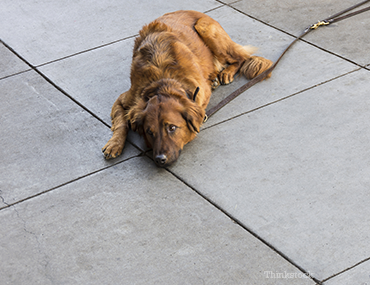Dr. Phil Zeltzman is a mobile, board-certified surgeon in Allentown, PA. Find him online at www.DrPhilZeltzman.com. He is the co-author of “Walk a Hound, Lose a Pound” (www.WalkaHound.com).
Chris Longenecker, a Certified Veterinary Technician in Reading, PA, contributed to this article.
Dog owners are constantly reminded to keep their dogs on a leash. That's the right thing to do, right? It’s certainly true that leashes and collars can be great. Unfortunately, there are several ways to get into serious trouble when a leash or a collar is used incorrectly. I can think of several instances when dogs have needed medical or surgical care over the years after hurting themselves with a leash or a collar:
- Bruiser the Maltese, who was taking a walk in the dog park with his owner at the end of a retractable leash, saw another dog and ran to greet him. He startled the other dog and that dog started barking. Concerned about a possible dog fight, and caught off guard, Bruiser's owner jerked the leash to get him out of harm's way. Unfortunately, the owner's quick reaction caused severe trauma to the neck. Bruiser had to wear a neck brace and take pain medications for one month.
- Simba the Australian shepherd was attached to an overhead line tied between two trees in the back yard. The line gave him the freedom to run back and forth while unattended. Then one day, his owners heard Simba scream in pain. They ran outside and found him crying, holding his rear leg up. The owners rushed him to the vet. Radiographs revealed a shattered tibia (shin bone). We successfully fixed the bone surgically, but this is a good reminder that these tethered lines can be very dangerous. To be fair, a fracture is a rare result. A much more classic injury from these lines is neck trauma when the dog runs just a little bit further than the leash allows him to. These injuries are just as likely to occur when dogs are tied to a stationary object.
Retractable leashes
While retractable leashes allow your dog to have more freedom, they sometimes provide a false sense of security.

Tiny the Rottie was walking with his owner on the sidewalks of a busy street at the end of a 20 foot retractable leash. He must have seen something really exciting on the opposite sidewalk because he suddenly ran across the street to investigate it. Unfortunately, he was hit by a car along the way. That's how I met Tiny, who ended up with multiple fractures of the pelvis and a dislocated hip.
Retractable leashes can also hurt humans: there have been cases of rope burn, badly hurt fingers (very badly), and broken legs. One little girl even sustained eye damage because of a faulty retractable leash.
Many behaviorists and trainers actually dislike retractable leashes.
Collars
If leash troubles weren't enough, collars can also be a source of danger.
A very sad, almost barbaric, situation can occur when a collar is kept on a growing puppy (sensitive souls should skip this paragraph-it is graphic). While the puppy grows, the collar does not. The end result might very well be what we call an "embedded collar." This is a horrible situation where the collar literally grows into the skin and needs to be surgically removed under general anesthesia. Then the raw skin has to be reconstructed to close the circular wound around the neck.
A loose collar is not much better; we often see this in vet clinics when we use a pet owner's own leash and collar. If the pet resists following us to the treatment room by pulling in the opposite direction, they often slip right out of the collar. If this happens in an exam room, nobody gets hurt. But this has happened to some of our patients who were in the streets or near an aggressive dog.
A good rule of thumb is that one to two fingers should fit under the collar. You should find out that this is comfortable for your pet.
Shock collars
A painful situation can occur when a dog wears a shock collar or an "invisible fence" collar and it causes a burn or irritation to the area where the prongs touch the skin. These collars are beneficial if used appropriately, but serious complications can occur if they are not used correctly.
Of course, we are huge advocates of leashes and collars. Just be aware of the dangers and act accordingly--especially with retractable leashes--and enjoy your next dog walk.
If you have any questions or concerns, you should always visit or call your veterinarian -- they are your best resource to ensure the health and well-being of your pets.
